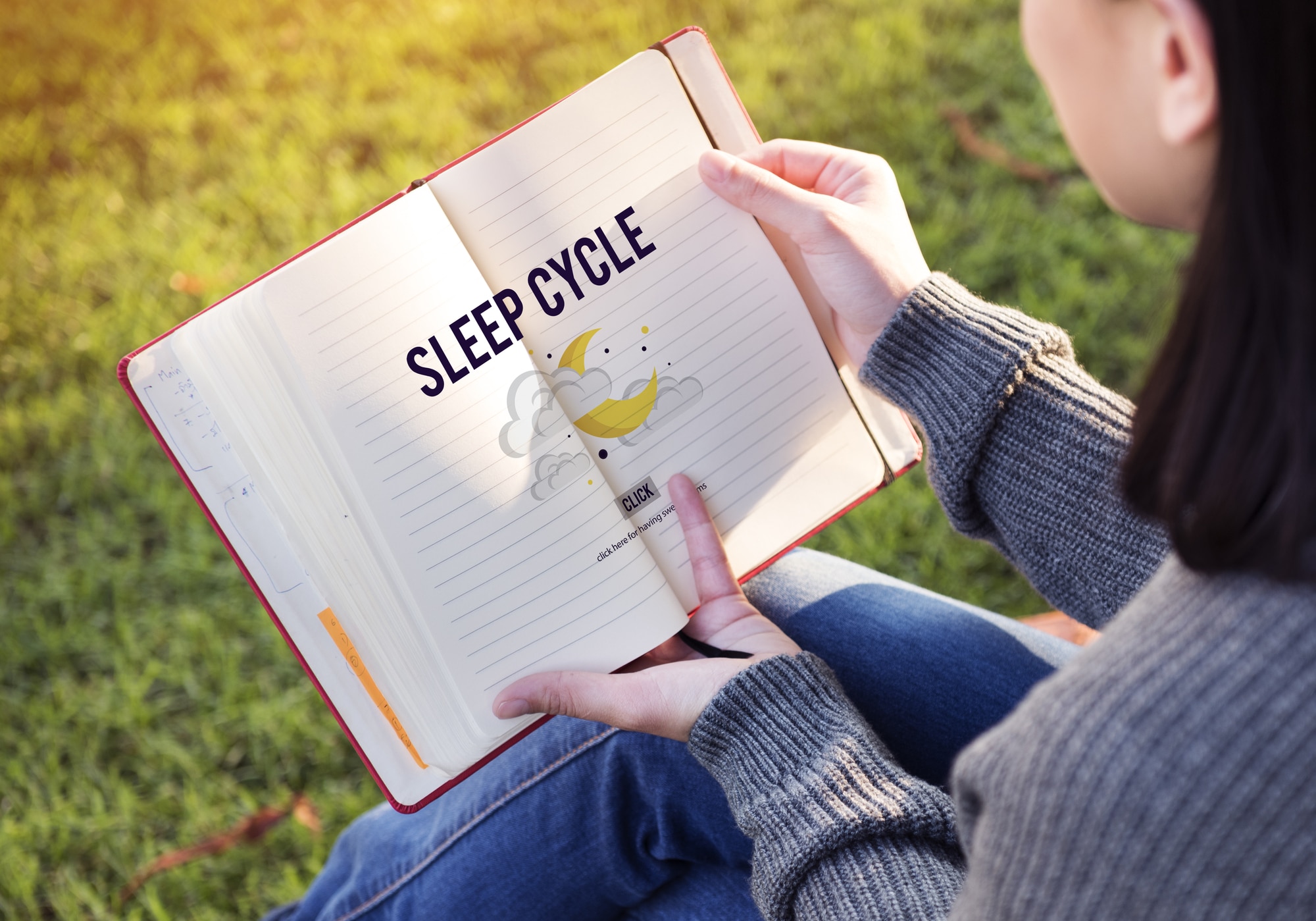When we sleep, our body cycles through different sleep stages. A good night’s sleep consists of five main stages of sleep, but what does that mean exactly? Why do some sources report five stages and others only four? What differentiates the individual stages of sleep, and why is each one important? When do you dream? Are you cycling through all of the correct stages while you sleep? If you have ever wondered about these questions or been curious about your brain activity when you sleep, then you have come to the right place. Join us while we explore the answers to these questions and more.
This in-depth analysis of each stage of sleep will help you examine and evaluate your sleep patterns. See how they measure up to a healthy sleep schedule. Understanding sleep will also help you to alter your sleep habits as needed. You will wake up rested and ready for peak performance throughout the entire day.
An Overview of Sleep Cycles

Before we get technical, let’s cover the basics. What is a sleep cycle? When someone discusses sleep cycles, they are referring to your body’s natural progression through the various stages of sleep, from non-REM sleep to REM sleep. What your brain and body focus on during each particular phase define these stages, but more on that later.
How long are sleep cycles? The answer depends on a few variables, including age, genetics, and environmental factors. But for the average person, a sleep cycle lasts approximately 90 minutes to 120 minutes. Your sleep cycle repeats itself, from stage 2 to 5, until you wake up in the morning. Do you know the number of sleep cycles you experience in a night? How long does a sleep cycle last? Given the time it takes to cycle through the stages of sleep, you will ideally experience 4-5 complete cycles each night. Also, the first sleep cycle you progress through is generally a bit shorter. It is only about 90 minutes in length, with the other periods lasting to about 100-120 minutes.
2 Main Types of Sleep
The two main types of sleep are called REM sleep and non-REM sleep. REM is an acronym for rapid eye movement. The REM stage is characterized by rapid, back-and-forth eye movements. Your sleep is considered to be more active. During non-REM or non-rapid eye movement sleep, also known as NREM sleep, these eye movements do not occur. Your sleep is considered to be quieter. Non-REM sleep encompasses three of the five total sleep phases.
Are There 4 or 5 Stages in Your Sleep Cycle?
How many stages of sleep are there? Interestingly, there is conflicting information on the categorization of the different sleep stages. The most recent research and medically reviewed information indicate that there are currently five recognized stages of sleep. However, stages 3 and 4 are put together because they both refer to subcategories of deeper sleep. Stage 3 is the gradual start of deep sleep caused by your brain’s production of slower delta brain waves. Stage four is when your brain waves amplify, and you fully achieve long, uninterrupted sleep.
What Are the 5 Stages of Sleep, and How Can You Tell Them Apart?
Now that we have a basic knowledge of sleep cycles and the different stages of sleep, let’s dig a bit deeper and get a more detailed understanding. What are the different stages of sleep, specifically? How do stage 3 and 4 sleep differ from other stages? Also, how much do the individual phases encompass? Is it a couple of minutes, an hour of sleep, or maybe a little more?
Stage 1 Sleep
Stage 1 sleep is the first of the non-REM sleep cycle stages. This non-REM sleep activity only lasts for a brief period, usually not exceeding seven minutes. During stage 1 NREM sleep, you begin transitioning from being awake to being asleep. When you enter this phase of light sleep, your brain and body react by slowing down your breathing, eye movements, and heart rate. Your muscles also start relaxing during Non-REM sleep. But occasionally, your muscle may twitch, which could have even woken you up before.
NREM sleep is the lightest phase of sleep, and you are awakened easily during this part of your sleep cycle. During light sleep, there’s also a significant change in our brain activity. Our brain waves also begin slowing down and producing alpha and theta waves during this non-REM phase. When you take a “cat nap,” you are referring to a brief rest in this Non-REM sleep stage.
Stage 2 Sleep
After stage 1 comes the next non-REM stage. You spend about 40-60% of your total time asleep in the second non-REM sleep stage. During stage 2, you continue to relax, and your internal body temperature drops gradually. Your eye muscle also relaxes, movement stops, and your brain waves continue to slow down in this non-REM sleep phase. However, in stage 2 non-REM sleep, your brain activity now produces sleep spindles, which are sudden frequency spikes in brain waves. These brain waves are called sleep spindles because of how they look on an electroencephalogram (EEG). Sleep spindles are believed to aid in memory consolidation.
Stage 2 sleep is still fairly light even though you spend more of your total sleep time in this phase than any other. When taking a “power nap,” you will want to wake up after this phase of light sleep before you enter deeper sleep, which is harder to wake up from.
Stage 3 Sleep
Stage 3 or slow-wave sleep is the beginning of deep sleep signified by your brain’s production of slower delta waves, and the complete absence of muscle or eye motion. During stage 3 slow-wave sleep (SWS), it becomes more difficult to wake up, and you are less responsive to outside stimuli. As we mentioned above, stage three and four are grouped together due to their subtle differences in brain activity, which were undetected for many years.
Stage 4 Sleep
While both stage 3 and 4 are considered SWS sleep phases, stage four is the main component of deep sleep. The brain’s production of even slower delta waves and the complete relaxation of your entire body signifies this. As an adult, you spend 13-23% of your total sleep time. This number is greater in children and adolescents as their bodies and brains continue to grow and develop. Your first deep slumber during the night is the longest and can last around 45-60 minutes. After that, the duration of stages three and four will become shorter, and it will be lesser as the night progresses. This slow-wave delta sleep is the most restorative phase of sleep, making it necessary for normal functioning throughout the day.
Stage 5 Sleep
Stage five is called REM sleep, or rapid eye movement sleep, and it comprises approximately 25% of your total sleep period. The first period of rapid eye movement (REM) sleep that you experience is short, but the period you spend in it increases throughout the night. During the REM stages, your heart rate, blood pressure, and brain activity increase to almost waking levels making this a more active phase of sleep. Breathing during sleep also speeds up on stage five and may even become irregular.
This REM sleep phase is also restorative and essential for healthy bodily functioning. Another noticeable difference experienced during phase five of REM sleep involves temporary sleep paralysis. The muscles become temporarily paralyzed for a brief period when you dream. When your limbs are temporarily paralyzed, this paralysis actually functions to prevent you from acting out your dreams in real life.
What Is Deep Sleep?
What is the deepest stage of sleep? You guessed it. Its stages three and four of non-REM sleep. During these stages, your brain waves slow down and have a large amplitude. This type of brain waves is called delta waves.
Is Deep Sleep Important?
Deep sleep is aptly named because this is the most difficult stage of sleep to wake someone from, especially if they are already sleep-deprived from the previous night or nights. This detachment from external stimuli helps your body and brain perform the restorative and regenerative processes that you need to effectively recover from the previous day’s activities while simultaneously storing energy for the following day’s activities. Your brain also releases the human growth hormone during this time to promote the regeneration and active recovery of your muscle, joints, brain functioning levels, immune system, and your body overall.
It is an integral and necessary part of your sleep cycle if you want to wake up rested and refreshed the next day. If you do not get enough quality sleep, you will most likely feel tired and even irritable in the morning. If you suffer from sleep deprivation for an extended period, it can lead to overall health problems affecting your entire body and mental health.
While you are experiencing this stage, it is very hard to be woken up. External stimuli often go unnoticed, even if you tend to wake easily during other sleep stages. Not so surprisingly, this is also when people experience sleepwalking, which is known to be difficult to wake up from.
If you like to nap during the day, whether or not you allow yourself to reach this stage during your nap can affect how easily you will be falling asleep that night. If you go from light sleep to deep sleep during a nap, then it is likely, you will not feel sleepy at the usual time that evening. Unless you are trying to stay up unusually late for something, we recommend keeping your naps short, so you don’t interrupt your normal sleep pattern.
Is REM Sleep Important?
Is REM sleep good or important? Absolutely! As the second most restorative sleep phase, REM sleep stages should not be overlooked or skipped when at all possible. During REM sleep, your body focuses on improving learning capabilities and overall memory consolidation. During this phase of sleep, REM or rapid eye moments signify that your neurons are performing activities similar to what they usually do when you’re awake.
During sleep, REM is vital because this period provides your brain with the dedicated time it needs to review, build up, and process all of the information it absorbed during the previous day. Once REM sleep is completed, your brain sorts the information and stores it in your long-term memory accordingly.
How long are REM sleep cycles, generally? The answer to this question varies depending on how many hours you have been asleep. Your first REM sleep cycle usually occurs approximately 90 minutes after you fall asleep and lasts for about 10 minutes. Each subsequent REM sleep cycle increases in length of duration, and your final REM cycle can last as long as one hour.
When Do We Dream?
During what sleep stage do you dream? As we noted above, the majority of your dreams occur while you are in the REM sleep stage. During REM sleep, your brain is active enough to participate in dreaming while it sorts through the previously absorbed information. Dreams are also believed to be one way your brain enhances its process of sorting through the information it receives during the day. Many people initially dream of simple daily activities and occurrences from earlier in the day, even if they can not remember them when they wake up in the morning. Dreams may also be a function of your body to process emotions, and any stress you may currently be feeling.
While you don’t experience all your dreams during REM sleep, they are often the most vivid. Many people experience their most memorable dreams when they are awoken in the morning and attempt to fall back asleep. However, dreaming is different for everyone, and we are still unsure of the exact purpose of dreams in the first place.
Sleep Patterns Change with Age

Healthy sleep patterns change with age, as do the length of time spent in each of the different sleep cycles. You probably already know that babies, children, and even teens sleep more than a typical adult. You may have also heard that older people may have difficulty falling asleep and tend to sleep fewer hours per night, but how does this interact with your stages of sleep?
The percentage of time spent in each phase of sleep varies with age. When you are young, you spend significantly more time in sleep stages three and four. Babies spend the most time in these stages. As you grow and your brain develops, it is essential to get a significant amount of this long, quality sleep to facilitate proper development and healthy functioning.
Babies also spend the most amount of time in REM sleep compared to other age groups. Most babies spend as much as 50% of their total hours of sleep time in REM. This REM percentage decreases with age until it reaches only about 20-25% of the total sleep time in adults, and even less in the elderly.
If you think about it, it makes perfect sense. As a baby, everything in the world is new, and you are processing a huge amount of information daily, so more REM sleep is needed. You are also growing rapidly as a child, so you need more of it to enable growth and development at a healthy level. Adversely, when we don’t experience as much growth when we get older, we need less heavy sleep. The result of significantly less REM sleep in older individuals results in more forgetfulness, a common trait found in the elderly.
So, how many sleep cycles do we need? The answer depends on your age and what stage of development you are currently experiencing. More sleep cycles for small children and adolescents, and fewer and fewer sleep cycles as we age.
How Does Your Circadian Rhythm Fit into All This?
Your circadian rhythm is an internal biological mechanism that is closely tied to sleep stages. Its way of doing this is by regulating when you are awake and when you are asleep. In turn, your biological clock adjusts to it. Similarly, it is both controlled and affected by the release of hormones in your body. The temperature of your environment, your internal body temperature, and your metabolism also affect this rhythm.
Consider Tracking Your Sleep Cycle at Home
There are many new products on the market today that allow you to monitor your sleep cycles like those recognized by the National Sleep Foundation (NSF). Try using a wearable item, like a headband, watch, or bracelet to help you track your stages of sleep so you can find out if you lack in any areas. These new monitoring tools track your heart rate, respiration, and blood pressure to analyze your sleep patterns and determine how much time you spend in each of the different sleep levels. Keeping a sleep journal and take note of any relevant experience. A sleep journal, in conjunction with the relevant non-personal data (e.g. blood pressure, heart rate, breathing, and oxygen saturation) our preferred device collects, could help us determine if we need to make changes in our sleep routine to improve overall mental and physical functionality.
Balance Your Sleep Stages and Improve Sleep Quality Overall
What if you track your sleep, and you find out your sleep stages are imbalanced? Don’t worry, even if you have a hard time falling asleep at night, there are several easy things you can do to efficiently balance and improve the quality of sleep you get each night.
1. Get the Amount of Sleep Your Body Needs
For most adults, the proper amount of sleep is around eight hours. However, this varies from person to person. Some people experience no problems falling asleep and can even get 9 hours of sleep each night. Only you know how much sleep your body needs to feel well-rested. Children need more sleep than adults, and often they can sleep for up to 14 hours a day, mainly if you include daily naps.
2. Keep Your Bedroom Cool and Dark
You sleep better when your body temperature drops so you’re not overheating and when you are not disturbed by light of any kind. Sorry, but this includes the light emitted from electronics too. To improve your sleep, power everything down and draw the curtains.
3. Don’t Eat or Exercise Right Before Bed
Eating a big meal before bed diverts your body’s energy to digestion instead of allowing it to focus on restorative sleep. Exercise right before bed will likely make it harder to fall asleep when you lie down. Exercise usually awakens the muscle you trained and gives you an energy boost. Hence, to help you fall asleep easier at night, try to work out at least a couple of hours before you plan on going to bed.
4. Make a Sleep Routine That You Follow Every Night
Having a healthy sleep routine is key to preventing sleep disorders. Do a sequence of activities before bed to alert your body that it is almost time to go to sleep. This could include relaxing muscle stretches, a bath, or even simple activities like combing your hair, brushing your teeth, and washing your face.
Also, to get enough sleep, go to bed and wake up at around the same time each night, even on the weekends. This will lead to a more balanced sleep schedule that leaves you feeling more refreshed and awake in the morning.
Tip: If you believe you have a sleep-related disorder, seek the professional opinion of a sleep specialist. A sleep specialist is a doctor who is licensed to diagnose and treat sleep-related conditions. Your doctor can provide medical advice, diagnosis, or treatment of sleep disorders.
Final Thoughts
Each one of the different sleep stages is important for various reasons. The first stage of sleep is particularly important even though you only fall asleep for a brief period of a few minutes. Without the first sleep stage, you would never truly fall asleep or reach the following four stages. Experiencing issues during the first stage results in sleep disorders like insomnia. Then the second stage of sleep helps your body transition from one step to the next and encompasses the most time overall. Next, the third and fourth stages, also known as deep sleep, work to restore and regenerate brain, muscle, and skin tissue. Lastly, the fifth stage processes information and stores memories for later recall.
All five stages of sleep are a vital part of your overall sleep health and general health, as well. If you are not getting enough sleep due to sleep disorders or it is frequently interrupted, then it is not uncommon to feel tired or irritable the following day. So do your best to get the rest you need on a consistent and regular basis. You will thank yourself in the long run.
Additional Resources
- How to Fix Your Sleep Schedule
- Waking up Dehydrated
- How to Sleep with Sciatica
- How to Dispose of a Mattress






